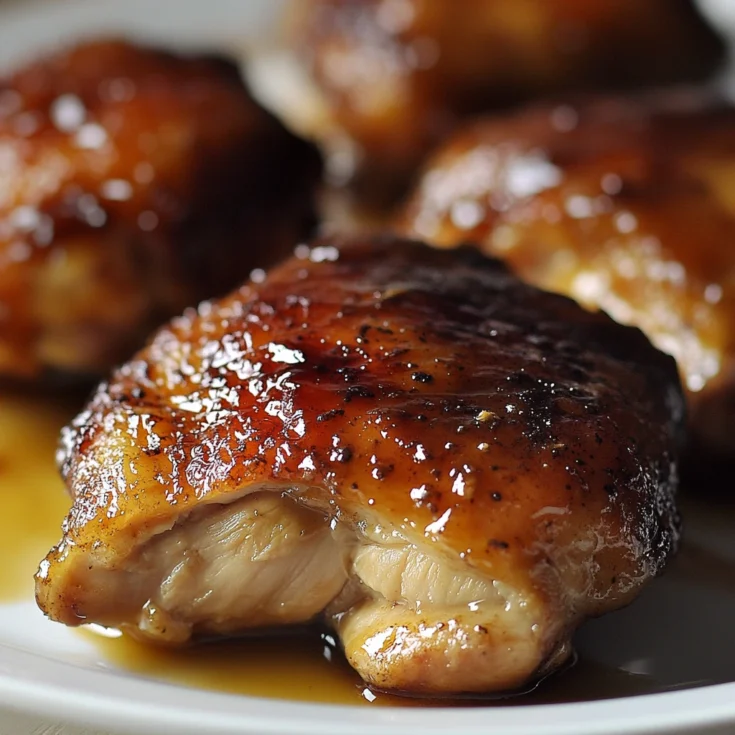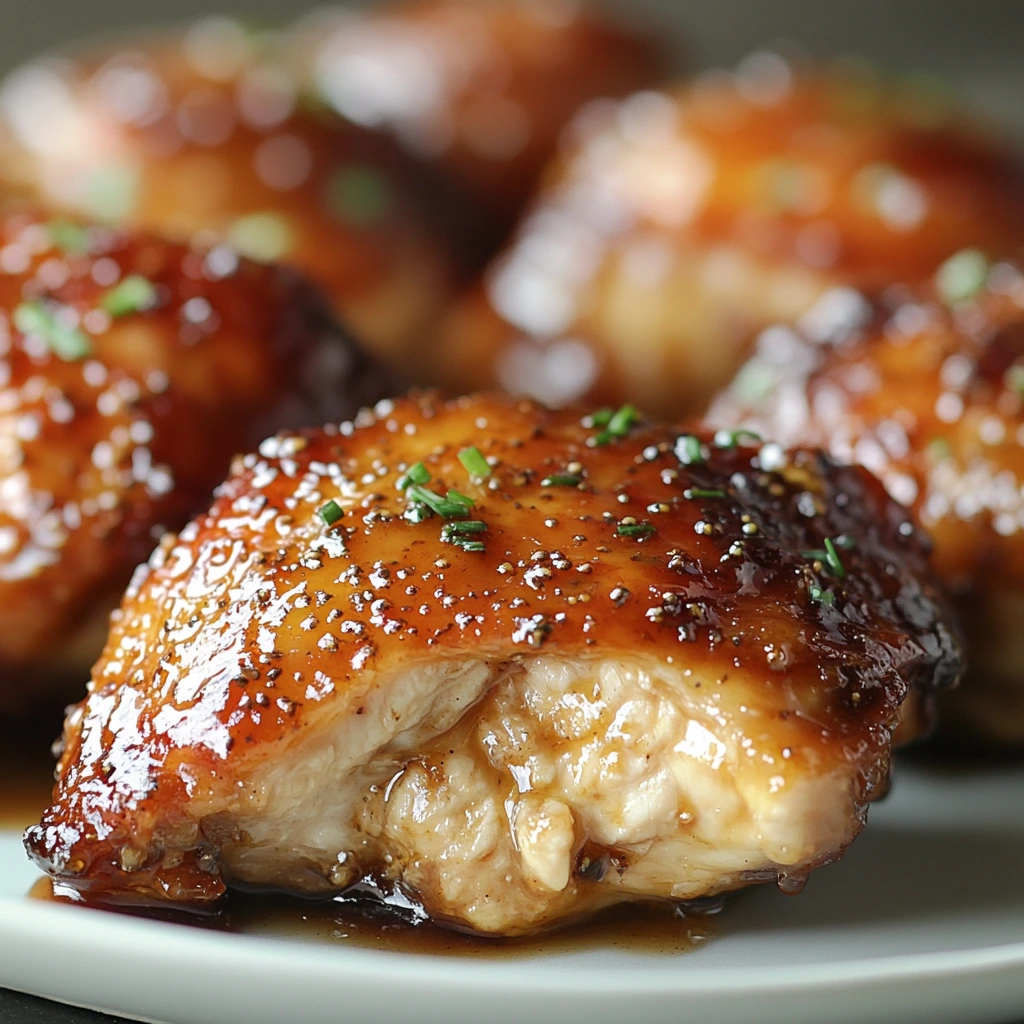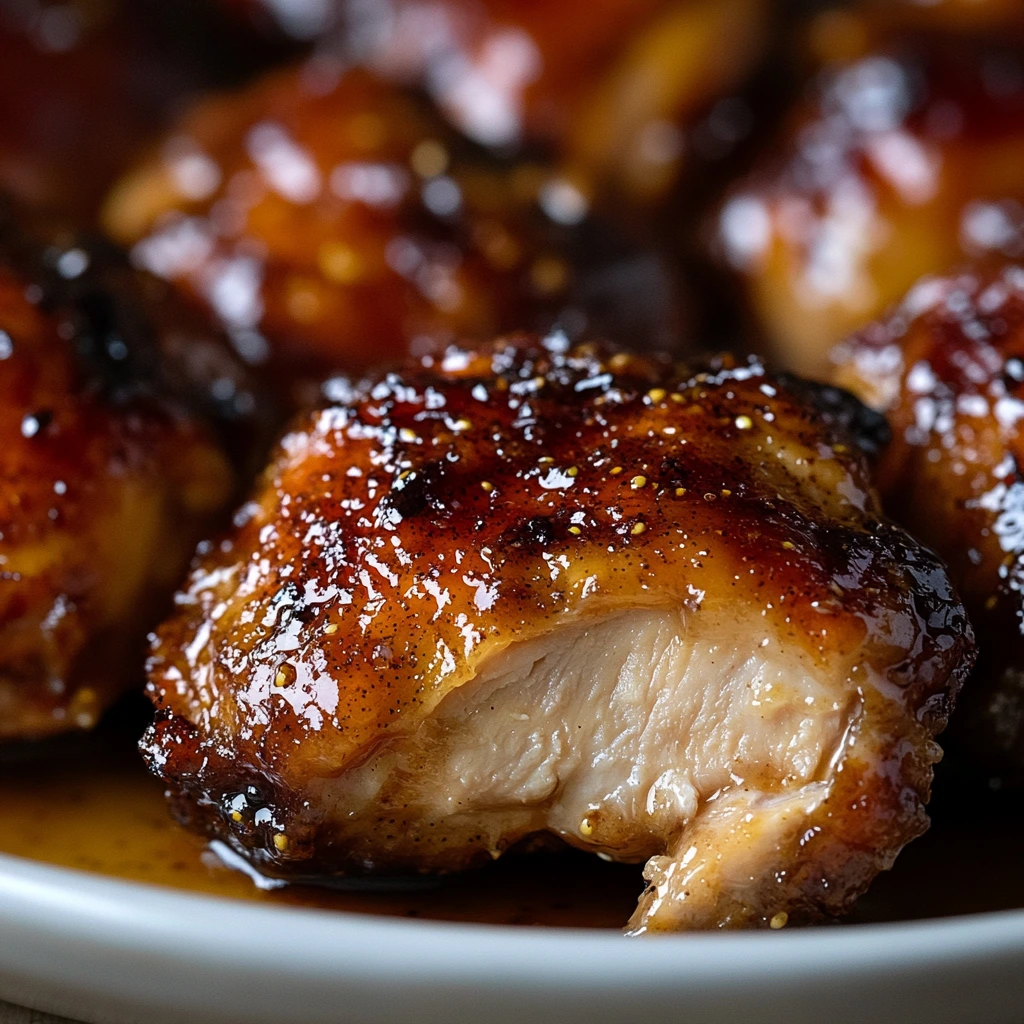The Allure of Sweet and Savory Flavors
Few flavor combinations are as satisfying as the union of sweet and tangy. Brown sugar, with its deep molasses notes, pairs perfectly with the bold sharpness of Dijon mustard. Together, they create a glaze that clings beautifully to chicken, enhancing every bite with contrast and balance.
This sweet-savory duo isn’t just tasty—it’s a sensation that wakes up your taste buds. The sugar caramelizes as it cooks, forming a slightly crisp coating. Meanwhile, Dijon brings a mild heat and depth that balances the sweetness without overwhelming it. It’s this harmony that turns a simple chicken dish into something unforgettable.
When this glaze meets chicken thighs, magic happens. The rich flavors of the marinade soak into the tender meat, giving it a taste that’s both rustic and refined. Whether served for family dinner or meal prep, this dish stands out for its crowd-pleasing flavor and effortless preparation.
Why Chicken Thighs Are Ideal
Chicken thighs are the perfect canvas for bold, flavorful glazes. Unlike leaner cuts, thighs retain moisture during cooking, staying juicy inside and crisping up on the outside. This makes them a top choice for baking, grilling, or searing.
Their higher fat content doesn’t just help with texture—it enhances flavor, too. Each bite carries more richness, which pairs wonderfully with the sweet and tangy sauce. Bone-in thighs, especially, cook evenly and add depth to the final dish.
From weekday dinners to weekend gatherings, chicken thighs offer dependable results. They’re budget-friendly, versatile, and hard to overcook. For recipes like brown sugar Dijon chicken, they’re not just a good option—they’re the best one.
Selecting Quality Ingredients
Choosing the Right Chicken Thighs
When making brown sugar Dijon chicken thighs, the cut you choose matters. Bone-in thighs deliver maximum flavor. They stay moist during cooking and develop a deep, savory taste that boneless options sometimes lack.
If you prefer ease of eating, boneless thighs still work well. Just watch them closely—they cook faster and can dry out quickly if overcooked.
Skin-on thighs add another layer of richness. As they roast, the skin crisps up beautifully, locking in juices and boosting texture. Skinless thighs are leaner and soak up more of the marinade, but they miss that crispy, caramelized finish.
For the best results, go with organic or free-range chicken. These options often have better texture and taste due to a healthier diet and living conditions. The difference is subtle but noticeable, especially in recipes that let the meat shine.
The Role of Brown Sugar
Brown sugar is essential to the sweet-savory balance in this dish. It not only sweetens but also caramelizes during cooking, forming a rich glaze that clings to the chicken.
Light brown sugar has a milder molasses flavor, making it ideal for a delicate glaze. Dark brown sugar, on the other hand, adds deeper, almost smoky notes. Both work—your choice depends on how bold you want the flavor to be.
During roasting, the sugar melts and thickens, helping the glaze cling to the meat. It also promotes browning, giving the thighs a golden, appetizing crust.
Dijon Mustard Varieties
Dijon mustard is more than just a condiment—it’s the backbone of the marinade. Traditional Dijon is smooth and sharp, while whole grain versions add texture and a milder bite.
Use traditional for a sleek glaze that spreads evenly. Whole grain is ideal if you want visual appeal and a rustic touch. Try different brands to find your favorite; each has its own intensity and finish.
Additional Flavor Enhancers
To round out the glaze, garlic is a must. It adds warmth and depth. Herbs like thyme and rosemary introduce earthy notes that complement the mustard.
Spices such as paprika or black pepper elevate the flavor without overpowering the main ingredients. Optional boosts like soy sauce add umami, while a dash of Worcestershire gives a complex tang.
You can mix and match based on preference. These extras help make the dish your own.
Preparation Techniques
Marination Tips
Marinating adds layers of flavor and tenderizes the chicken. For best results, marinate for at least 30 minutes. For deeper flavor, refrigerate overnight.
Always marinate in a sealed container or zip-top bag. Keep it cold—never let chicken sit out at room temperature with marinade.
Before cooking, remove the chicken from the fridge and let it sit for 10–15 minutes. This helps it cook evenly and prevents the meat from seizing up under heat.
Cooking Methods
Baking is the go-to method. Set your oven to 400°F. Bake for 35–40 minutes, or until the internal temperature hits 165°F. You’ll get crisp skin and juicy meat every time.
Grilling adds a smoky touch. Use medium heat and cook each side for about 6–7 minutes. Watch closely—sugars can burn quickly on the grill.
Pan-searing is great for crisping the outside fast. Start in a hot skillet, skin side down. After browning both sides, transfer to the oven to finish cooking. This method gives you texture and flavor in every bite.
Step-by-Step Cooking Guide
Oven-Baked Method
Start by preheating your oven to 400°F (200°C). A hot oven ensures caramelization from the start. While the oven heats, line a baking dish or tray with parchment paper for easy cleanup.
Arrange the chicken thighs in a single layer. Leave space between each piece to allow air circulation. This helps the glaze bubble and set instead of steaming the chicken.
Before baking, spoon extra marinade over the chicken. Bake uncovered for 35–40 minutes. Halfway through, baste the thighs with pan juices for added flavor.
To check doneness, insert a meat thermometer into the thickest part. When it reads 165°F (74°C), the chicken is perfectly cooked. Let the thighs rest for 5 minutes before serving to lock in moisture.
Grilling Method
For a smoky version, grilling is ideal. Preheat your grill to medium heat and lightly oil the grates. While it heats up, bring the chicken to room temperature. Cold meat can seize on the hot grates and cook unevenly.
Place the thighs skin side down over indirect heat first. This prevents flare-ups from the sugary marinade. After 5–6 minutes, flip and cook over direct heat for another 5–7 minutes.
Use two heat zones—one hot, one cooler—for better control. If the glaze starts to char too quickly, move the chicken to the cooler side. Brush with glaze as it cooks to layer flavor.
Monitor with a thermometer. Once the internal temperature hits 165°F, remove from the grill and rest the meat briefly.
Pan-Searing Method
Pan-searing gives the chicken a golden crust. Use a heavy skillet, preferably cast iron, for even heat. Preheat it over medium-high heat, then add a small amount of oil.
Place the thighs skin side down. Let them sear undisturbed for 5–6 minutes to build color. Flip and cook for another 4 minutes.
For full doneness, transfer the pan to a 375°F (190°C) oven for 10–15 minutes. This step finishes the cooking gently and preserves juiciness. Always rest the chicken before slicing or serving.
Expert Tips for Success
Achieving the Perfect Glaze
A well-balanced glaze transforms good chicken into a showstopper. Use equal parts brown sugar and Dijon mustard to start. Adjust based on your taste—add more mustard for tang, or sugar for sweetness.
To thicken the glaze, simmer the extra marinade in a saucepan. Stir frequently until it reduces to a syrupy consistency. Then drizzle over the cooked chicken for a glossy finish.
A dash of lemon juice or a touch of vinegar can brighten the glaze, balancing the sugar with acidity. This simple tweak keeps the dish from feeling too heavy.
Ensuring Juicy Chicken
The secret to juicy chicken lies in cooking time and resting. Don’t rush or overcook. Once the internal temp hits 165°F, remove the chicken immediately. Overcooked thighs become tough and lose flavor.
Always let the meat rest for at least 5 minutes after cooking. This allows juices to redistribute, keeping the inside moist and flavorful. Cut too soon, and you’ll lose those juices to the plate.
Presentation and Garnishing
How you serve the chicken matters. Sprinkle freshly chopped parsley or thyme over the top for a pop of green and added aroma.
Serve the chicken on a white plate or wooden board to highlight the golden glaze. Add a few lemon wedges or a side of colorful veggies for contrast.
Drizzle leftover glaze or sauce around the plate for a gourmet touch. It’s simple but effective—and your guests will notice the effort.
Complementary Side Dishes
Vegetables
Pairing your chicken with vibrant vegetables enhances both flavor and nutrition. Roasted Brussels sprouts bring a nutty depth that complements the sweet glaze. Carrots add natural sweetness and balance the tangy mustard. Green beans offer crunch and a fresh finish.
If you prefer something lighter, go for steamed vegetables. Broccoli florets, steamed just until tender, soak up extra glaze beautifully. Asparagus, with its grassy notes, pairs well with the bold chicken flavor and adds elegant color to your plate.
Keep the seasoning simple on veggies—olive oil, salt, and a hint of garlic let the chicken stay center stage.
Starches
Starchy sides make this dish satisfying and filling. Creamy mashed potatoes are a comforting match. Their smooth texture contrasts with the caramelized chicken crust.
For a lighter choice, try rice pilaf or fluffy quinoa. These grains absorb any extra sauce, ensuring every bite is flavorful. Buttered noodles are a classic that appeals to both kids and adults. Couscous works well, especially if you’re short on time—it cooks in minutes and adds a subtle nuttiness.
Choose your starch based on your occasion. Hearty for dinner, light and quick for lunch.
Salads
A crisp salad brings freshness to the plate. Mixed greens with vinaigrette cut through the glaze’s richness and cleanse the palate. Add sliced red onions, cherry tomatoes, or shredded carrots for crunch and color.
Coleslaw is another great option. Its tangy dressing mirrors the mustard notes in the chicken, tying everything together. If you’re after something refreshing, a cucumber salad with dill or vinegar adds brightness and cool contrast.
With the right salad, your meal feels complete yet balanced.
Recipe Variations
Spicy Kick
If you like heat, add a spicy twist to the classic glaze. A pinch of chili flakes brings warmth without overpowering the base flavors. You can also mix in a splash of your favorite hot sauce for bold flavor.
For deeper spice, incorporate cayenne pepper. Start small—1/8 teaspoon goes a long way. The heat enhances the sweetness and adds excitement to each bite.
Asian-Inspired Twist
To give your dish an Asian flair, swap part of the mustard for soy sauce. Add a splash of sesame oil to the glaze for richness. These changes bring out umami and pair well with rice or stir-fried vegetables.
Once cooked, top the chicken with chopped green onions and toasted sesame seeds. The result is visually appealing and full of flavor. This version works great with jasmine rice or steamed bok choy.
Honey Mustard Alternative
For a softer sweetness, try honey instead of brown sugar. Honey adds floral notes and a smooth finish. Use a 1:1 swap for brown sugar, or adjust based on your preference.
If using honey, reduce the amount of mustard slightly to maintain balance. This variation is great for kids or anyone who prefers milder flavors. Serve it with roasted potatoes or a garden salad for a wholesome meal.
FAQs on Brown Sugar Dijon Chicken Thighs
Can I use chicken breasts instead of thighs?
Yes, but expect different results. Chicken breasts are leaner and can dry out if overcooked. They also cook faster than thighs, so reduce the baking time to 20–25 minutes at 400°F. For added moisture, consider covering the breasts with foil for the first half of the baking time.
Thighs remain juicier and absorb marinade better. If you choose breasts, monitor them closely to avoid dryness.
How long should I marinate the chicken?
For best flavor, marinate the chicken for at least 30 minutes. If you have more time, marinate it for up to 12 hours in the refrigerator. This gives the brown sugar and mustard enough time to infuse the meat.
Avoid marinating longer than 24 hours. The acid and sugar in the marinade can break down the texture too much, making the chicken mushy.
Can I make this recipe ahead of time?
Yes, this dish is perfect for prepping ahead. You can marinate the chicken the night before, then bake it fresh the next day.
If cooking in advance, store the cooked chicken in an airtight container in the fridge. It will keep for up to 3 days. Reheat in the oven at 350°F until warmed through—this helps retain the glaze and texture.
Is there a substitute for Dijon mustard?
Yes, several options work well. Yellow mustard is milder and sweeter. Spicy brown mustard adds heat and texture. Honey mustard creates a gentler, sweeter glaze.
Choose your substitute based on the flavor profile you prefer.
How do I know when the chicken is fully cooked?
Use a meat thermometer to be sure. Insert it into the thickest part—165°F means it’s safe to eat. The juices should run clear, and the meat should be firm but not dry.
Brown Sugar Dijon Chicken Thighs

Savor the perfect blend of sweet and tangy flavors with these Brown Sugar Dijon Chicken Thighs. Ideal for weeknight dinners or special occasions, this dish promises juicy, flavorful chicken with a delightful caramelized glaze. Simple to prepare, yet rich in taste, it’s a guaranteed crowd-pleaser.
Ingredients
- 4 bone-in, skin-on chicken thighs
- ¼ cup brown sugar
- 2 tablespoons Dijon mustard
- 1 tablespoon olive oil
- 2 cloves garlic, minced
- 1 teaspoon fresh thyme leaves (or ½ teaspoon dried)
- Salt and freshly ground black pepper to taste
Instructions
☐ Preheat the oven to 400°F (200°C).
☐ In a small bowl, mix together brown sugar, Dijon mustard, olive oil, minced garlic, and thyme.
☐ Season chicken thighs evenly with salt and pepper.
☐ Place the chicken in a baking dish in a single layer.
☐ Brush each thigh generously with the brown sugar-Dijon mixture.
☐ Bake for 35 minutes, or until the internal temperature reaches 165°F (74°C).
☐ Remove from the oven and let rest for 5 minutes before serving.
Notes




